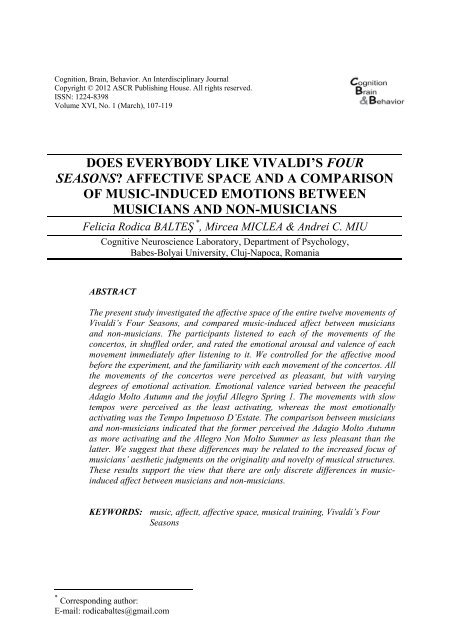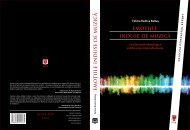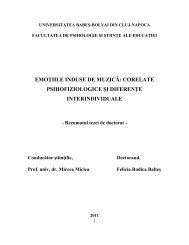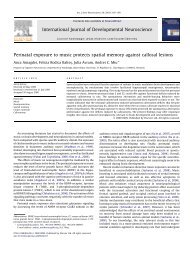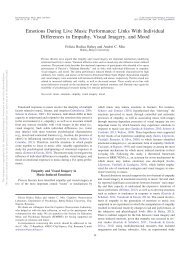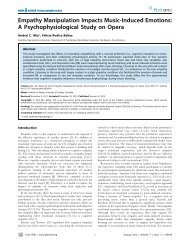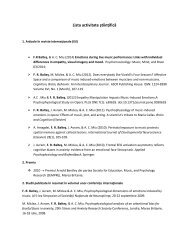o_19k6fnuqsqg41mt7rqp1c8pkueo.pdf
Create successful ePaper yourself
Turn your PDF publications into a flip-book with our unique Google optimized e-Paper software.
Cognition, Brain, Behavior. An Interdisciplinary Journal<br />
Copyright © 2012 ASCR Publishing House. All rights reserved.<br />
ISSN: 1224-8398<br />
Volume XVI, No. 1 (March), 107-119<br />
DOES EVERYBODY LIKE VIVALDI’S FOUR<br />
SEASONS? AFFECTIVE SPACE AND A COMPARISON<br />
OF MUSIC-INDUCED EMOTIONS BETWEEN<br />
MUSICIANS AND NON-MUSICIANS<br />
Felicia Rodica BALTEŞ * , Mircea MICLEA & Andrei C. MIU<br />
Cognitive Neuroscience Laboratory, Department of Psychology,<br />
Babes-Bolyai University, Cluj-Napoca, Romania<br />
ABSTRACT<br />
The present study investigated the affective space of the entire twelve movements of<br />
Vivaldi’s Four Seasons, and compared music-induced affect between musicians<br />
and non-musicians. The participants listened to each of the movements of the<br />
concertos, in shuffled order, and rated the emotional arousal and valence of each<br />
movement immediately after listening to it. We controlled for the affective mood<br />
before the experiment, and the familiarity with each movement of the concertos. All<br />
the movements of the concertos were perceived as pleasant, but with varying<br />
degrees of emotional activation. Emotional valence varied between the peaceful<br />
Adagio Molto Autumn and the joyful Allegro Spring 1. The movements with slow<br />
tempos were perceived as the least activating, whereas the most emotionally<br />
activating was the Tempo Impetuoso D’Estate. The comparison between musicians<br />
and non-musicians indicated that the former perceived the Adagio Molto Autumn<br />
as more activating and the Allegro Non Molto Summer as less pleasant than the<br />
latter. We suggest that these differences may be related to the increased focus of<br />
musicians’ aesthetic judgments on the originality and novelty of musical structures.<br />
These results support the view that there are only discrete differences in musicinduced<br />
affect between musicians and non-musicians.<br />
KEYWORDS: music, affectt, affective space, musical training, Vivaldi’s Four<br />
Seasons<br />
* Corresponding author:<br />
E-mail: rodicabaltes@gmail.com
108<br />
F. R. Balteş, M. Miclea, A. C. Miu<br />
INTRODUCTION<br />
Music fascinates us in so many ways. The power of music may lie within its ability<br />
to induce or modulate precious emotional states. Indeed, using various methods<br />
such as written reports, interviews or experience sampling, psychologists have<br />
shown that music can evoke a wide range of strong, self-relevant emotions<br />
(Gabrielsson & Lindström, 1993). Some of these emotions (e.g., wonder or feeling<br />
moved and admiring, transcendence or feeling overwhelmed and inspired) are more<br />
often induced by music compared to words or images (Zentner, Grandjean, &<br />
Scherer, 2008). Music can also be an agent of change or a promoter of the<br />
intensification or release of the existing emotions (Sloboda, 1992). For instance,<br />
music can intensify positive affect, vigilance and focus in the present, or facilitate<br />
emotion regulation functions (DeNora, 1999; Juslin, Liljestrom, Vastfjall, Barradas,<br />
& Silva, 2008; Sloboda, O'Neil, & Ivaldi, 2001).<br />
In line with similar efforts focused on the standardization of emotional<br />
words or pictures, Vieillard et al. (2008) have created the first archive of musical<br />
stimuli with affective norms. Such normatively-rated affective stimuli allow better<br />
experimental control in the selection of emotional stimuli, and facilitate the<br />
comparison of results across different studies conducted in the same or different<br />
laboratory (Lang, Bradley, & Cuthbert, 2005). The archive of Vieillard et al. (2008)<br />
includes short (mean 12.4 s), computer-generated musical stimuli. Such short<br />
stimuli have already been useful in describing the minimal time that is necessary for<br />
the successful classification of music according to emotional content. For instance,<br />
listeners without musical training were able to distinguish between cheerful and sad<br />
music in less than half a second from the beginning of the audition (Peretz, Gagnon,<br />
& Bouchard, 1998). However, the use of short stimuli in the study of music-induced<br />
emotions may be limited by several factors. The processing of emotional valence<br />
may be difficult in the case of short musical stimuli with low dynamics (Bigand,<br />
Vieillard, Madurell, Marozeau, & Dacquet, 2005). In addition, familiarity and the<br />
level of musical training influence the recognition of tunes, and these effects may<br />
be less obvious when short stimuli are used (Dalla Bella, Peretz, & Aronoff, 2003).<br />
Moreover, although studies using short musical stimuli emphasized that the<br />
recognition of basic emotions happens rapidly, several seconds may not be enough<br />
time for the full-blown psychophysiological responses associated with musicinduced<br />
emotions to develop. For instance, listening to a musically-complex and<br />
dramatically-coherent excerpt from Tosca induced positive emotion and autonomic<br />
arousal, seen in faster heart rate, but slower respiration rate and reduced skin<br />
conductance in comparison to baseline (Baltes, Avram, Miclea, & Miu, 2011). It<br />
has been argued that the complex arrangement of musical elements that is<br />
characteristic of everyday life music inspires a global affective response<br />
(Altenmuller, Schurmann, Lim, & Parlitz, 2002), and the use of entire musical<br />
pieces has a greater external validity when one investigates the emotional responses<br />
Cognition, Brain, Behavior. An Interdisciplinary Journal<br />
16 (2012) 107-119
F. R. Balteş, M. Miclea, A. C. Miu<br />
109<br />
to music (Baltes et al., 2011; Levitin, 2006; Rickard, 2004). Therefore, the aim of<br />
the present study was to explore the affective space of an entire musical<br />
composition. We chose to use Vivaldi’s Four Seasons because we suspected that<br />
the extensive popularity of this composition may be related to its emotional content.<br />
The Four Seasons has been previously used in cognitive research that investigated<br />
the effects of music on memory or categorization tasks in older adults<br />
(Mammarella, Fairfield, & Cornoldi, 2007; Thompson, Moulin, Hayre, & Jones,<br />
2005). Clearly, in light of the rapidly developing literature on music and cognition,<br />
mapping the affective space of everyday music will become increasingly necessary.<br />
The affective space of select musical stimuli has started to be mapped on<br />
the two dimensions of emotional arousal and valence (Grewe, Nagel, Kopiez, &<br />
Altenmuller, 2007; Vieillard et al., 2008). In Russell’s circumplex model, the<br />
conceptual distance between different emotions and the structure of affective<br />
experience are represented by a circle that has pleasure and displeasure (i.e.,<br />
valence) on the extremes of the left-right axis, and activation and sleepiness (i.e.,<br />
arousal) on the extremes of the upper-lower axis (Russell, 1980). Using the<br />
multidimensional scale method, which allows for emotions to be investigated<br />
without the use of linguistic labels, another study confirmed that emotional<br />
activation and valence are representative dimensions of music-induced emotions<br />
(Bigand et al., 2005). For instance, excerpts from Bach and Mahler were both<br />
perceived as pleasant, but they were distinguished by different degrees of emotional<br />
arousal (Flores-Gutierrez et al., 2007). Therefore, the present study used self-report<br />
measures of music-induced emotional arousal and valence.<br />
Another important aim of this study was to investigate whether there are<br />
differences in music-induced emotions between musicians and non-musicians. The<br />
traditional view is that in comparison to non-musicians, musicians have subtler and<br />
more complex knowledge about the musical tonalities typical to their culture, and<br />
they use it in order to improve their musical perception and memory (Dowling,<br />
1978; Krumhansl & Shepard, 1979). This perspective has been supported by studies<br />
from cognitive neuroscience, which identified various neuroanatomical and<br />
neurophysiological differences between musicians and non-musicians. For instance,<br />
musicians displayed increased grey matter density in Heschl’s gyrus (i.e., primary<br />
auditory cortex) and early auditory N19-P30 evoked potentials; these differences<br />
correlated with the musicality score on the Advance Measures of Music Audiation<br />
test (Hutchinson, Lee, Gaab, & Schlaug, 2003; Schlaug, Jancke, Huang, Staiger, &<br />
Steinmetz, 1995). However, non-musicians are also able to learn the tonal<br />
principles of their cultural musical idiom, and they accurately use this knowledge in<br />
music processing tasks in order to differentiate tonal from atonal melodies, for<br />
instance (Bartlett & Dowling, 1980; Frances, 1988). The emerging view is that all<br />
music listeners, whether musicians or non-musicians, may share a certain form of<br />
musical knowledge, which gives meaning to the music that they listen to (Halpern,<br />
Cognition, Brain, Behavior. An Interdisciplinary Journal<br />
16 (2012) 107-119
110<br />
F. R. Balteş, M. Miclea, A. C. Miu<br />
Bartlett, & Dowling, 1995). However, it is unclear whether music-induced affect is<br />
similar in musicians and non-musicians.<br />
Comparisons between musicians and non-musicians suggested that<br />
aesthetic judgments are also grounded on a common conceptual content that may be<br />
somewhat modified by musical expertise (Ystok et al., 2009). Using a verbal<br />
association task, it was shown that non-musicians generated more adjectives<br />
connected to the mood or emotional balance related to music, whereas musicians<br />
appreciated the inciting features of music, its novelty and originality (Ystok et al.,<br />
2009). The emotional categorization of short musical stimuli was equally reliable in<br />
musicians and non-musicians (Bigand et al., 2005). Using positron emission<br />
tomography, Blood and Zatorre (2001) found that the intensity of music-induced<br />
chills is associated with increased cerebral blood flow in reward areas (e.g., ventral<br />
striatum, midbrain, amygdala, orbitofrontal and ventral medial prefrontal cortex).<br />
This study included only musicians, on the assumption that this population is more<br />
likely to experience strong emotional responses to music, although the authors<br />
acknowledged that music training is not necessary to experience these responses<br />
(Blood & Zatorre, 2001). Clearly, further studies are required in order to clarify<br />
whether musical training impacts music-induced emotions.<br />
The objectives of the present study were: (1) to explore the affective space<br />
of Vivaldi’s Four Seasons; and (2) to compare the emotional arousal and valence of<br />
the Four Seasons between musicians and non-musicians. Although Vivaldi’s<br />
masterpiece is widely known, we expected differences in familiarity between<br />
musicians and non-musicians, and consequently we controlled for this variable in<br />
the comparisons of emotional responses. We hypothesized that the movements of<br />
Vivaldi’s Four Seasons would cover the entire affective space (i.e., positive and<br />
negative valence with varying degrees of emotional arousal), considering the<br />
composer’s intention to suggest the features of different seasons in his music.<br />
Another hypothesis was that, although we controlled for differences in familiarity<br />
with this particular composition, musicians would perceive the Four Seasons as less<br />
emotionally activating and pleasant than non-musicians, due to their knowledge of<br />
baroque music style.<br />
MATERIALS AND METHODS<br />
Participants<br />
N = 16 musicians and N = 14 non-musicians with ages from 22 to 40 years (mean<br />
age = 28 years), with good hearing abilities and no neurological disease records,<br />
have taken part in this experiment. The musicians group included instrument<br />
players and choir members from the National Opera House from Cluj-Napoca,<br />
Romania. The musicians benefited of an average of ten years of musical education<br />
and they were actively involved in musical activity at the time of this study. The<br />
non-musicians were recruited from the population of students in psychology from<br />
Cognition, Brain, Behavior. An Interdisciplinary Journal<br />
16 (2012) 107-119
F. R. Balteş, M. Miclea, A. C. Miu<br />
111<br />
Babes-Bolyai University. They did not report any specific musical education, but<br />
they all stated (i.e., inclusion criterion for this study) that they frequently listened to<br />
music and appreciate classical music.<br />
Materials<br />
The musical stimuli comprised the twelve movements of the Four Seasons by<br />
Antonio Vivaldi, performed by the Concerto Amsterdam orchestra conducted by<br />
Jaap Schröder (Hmf Musique D'abord, 2000). The movements, with durations<br />
between 1’30’’ and 5’30’’, were presented randomly (i.e., shuffled playlist) to the<br />
participants using a laptop and Logitech amplifying system set to a comfortable<br />
volume level.<br />
Immediately after the arrival at the laboratory, the participants filled in the<br />
general affect part of Positive and Negative Affect Schedule (PANAS-I) (Watson &<br />
Clark, 1994), which measures affective mood in the past few weeks until present.<br />
Emotional responses to music were measured on two 5-point Likert scales for<br />
arousal and valence. A third similar Likert scale measured the familiarity with the<br />
music. The extremes of the scales (e.g., whether 1 on the valence scale denoted<br />
“pleasant” or “unpleasant”) were counterbalanced between the concertos’ †<br />
movements. Each scale was explained to the participants, and they were warned<br />
that the extremes of the scales change from one movement to another, so they<br />
should pay attention to this aspect.<br />
Procedure<br />
After they completed PANAS-I, all the participants were taken to the laboratory<br />
where they listened to the musical stimuli in group. Before the first musical<br />
stimulus was played, the participants were informed that they will listen to<br />
Vivaldi’s Four Seasons, and were asked to attentively listen to the music no matter<br />
how familiar it was. The order in which the parts were presented was the following:<br />
1. Adagio Summer;<br />
2. La Caccia: Allegro Autumn;<br />
3. Tempo Impetuoso D’Estate Summer;<br />
4. Allegro Non Molto Winter;<br />
5. Allegro Winter;<br />
6. Largo e Pianissimo Sempre Spring;<br />
7. Adagio Molto Autumn;<br />
8. Largo Winter;<br />
9. Allegro Spring 1;<br />
10. Allegro Autumn;<br />
† Although usually presented together nowadays, each of the Four Seasons were written as<br />
individual violin concertos that were part of a larger set of twelve concertos (Vivaldi’s Opus 8)<br />
entitled The Contest between Harmony and Invention.<br />
Cognition, Brain, Behavior. An Interdisciplinary Journal<br />
16 (2012) 107-119
112<br />
F. R. Balteş, M. Miclea, A. C. Miu<br />
11. Allegro Spring 2;<br />
12. Allegro Non Molto Summer.<br />
Immediately after each part, the participants were instructed to use the<br />
scales that had been handed to them at the start of the experiment, in order to<br />
evaluate how activated the music made them feel (i.e., emotional arousal), how<br />
much they liked it (i.e., emotional valence), and how familiar the music was to them<br />
(i.e., degree of familiarity). There was no time limit, and each stage of the<br />
experiment (i.e., music listening followed by questionnaires) continued only when<br />
all the participants had finished completing the scales and unless they asked for a<br />
break.<br />
RESULTS<br />
Affective space. Repeated measure ANOVAs indicated that there were significant<br />
differences between the movements of the concertos on emotional arousal (F[11,<br />
18] = 30.65, p < 0.0001, partial η 2 = 0.82), valence (F[11, 18] = 2.69, p < 0.002,<br />
partial η 2 = 0.064), and familiarity (F[11, 18] = 10.57, p < 0.0001, partial η 2 = 0.16).<br />
An inspection of the affective space (Fig. 1) indicates that all the movements were<br />
perceived as pleasant (i.e., emotional valence scores above three), with the Adagio<br />
Molto Autumn having the smallest (score = 3.63) valence score (i.e., least pleasant)<br />
and the Allegro Spring 1 having the highest valence score (score = 4.67). The<br />
emotional arousal of the movements varied from the least activating part, the Largo<br />
e Pianissimo Sempre Spring (score = 1.63), to the most activating one, the Tempo<br />
Impetuoso D’Estate Summer (score = 4.47).<br />
The comparison of affect between musicians and non-musicians. In order to control<br />
for differences in familiarity with the musical stimuli, we first compared the<br />
familiarity scores between musicians and non-musicians. The results of the Student<br />
t-tests indicated that in comparison to non-musicians, musicians were more familiar<br />
with all the parts (t[10] = 13.08, p < 0.0001, Cohen’s d = 1.36). The sole exception<br />
was the Allegro Spring 1, which was equally familiar to both musicians and nonmusicians.<br />
Therefore, we included the familiarity scores in the ANCOVA analyses<br />
that compared emotional arousal and valence between musicians and nonmusicians,<br />
for all musical stimuli except the Allegro Spring. It is worth mentioning<br />
that there were no differences in previous affective mood between musicians and<br />
non-musicians (i.e., PANAS scores’ mean ± SEM: 27.63 ± 2.81 for musicians, and<br />
29.07 ± 6.59 for non-musicians), and consequently this variable was not included as<br />
a covariate in the following statistical analyses.<br />
Musical education had a significant effect on the emotional arousal scores<br />
of the Adagio Molto Autumn (F[1, 28] = 7.25, p < 0.01, partial η 2 = 0.2), with<br />
musicians having perceived this movement as more activating than non-musicians.<br />
Cognition, Brain, Behavior. An Interdisciplinary Journal<br />
16 (2012) 107-119
F. R. Balteş, M. Miclea, A. C. Miu<br />
113<br />
There were also significant differences between emotional valence scores of the<br />
Allegro Non Molto Summer (F[1, 28] = 5.63, p < 0.02, partial η 2 = 0.13), with<br />
musicians having perceived this movement as less pleasant than non-musicians.<br />
5.00<br />
Allegro Spring 1<br />
Largo E Pianissimo Sempre Spring<br />
Alegro Spring 2<br />
4.00<br />
Alegro Non Molto Summer<br />
Adagio Summer<br />
Tempo Impetuoso D'estate Summer<br />
Allegro Autumn<br />
AROUSAL<br />
3.00<br />
2.00<br />
Adagio Molto Autumn<br />
La Caccia: Alegro Autumn<br />
Allegro Non Molto Winter<br />
Largo Winter<br />
Allegro Winter<br />
1.00<br />
0.00<br />
0.00 1.00 2.00 3.00 4.00 5.00<br />
VALENCE<br />
Figure 1.<br />
The affective space of Vivaldi’s Four Seasons.<br />
Cognition, Brain, Behavior. An Interdisciplinary Journal<br />
16 (2012) 107-119
114<br />
F. R. Balteş, M. Miclea, A. C. Miu<br />
DISCUSSION<br />
This study explored the affective space of Vivaldi’s Four Seasons, as well as the<br />
potential differences between musicians and non-musicians on the affect induced by<br />
this musical composition. In line with others who argued that the use entire musical<br />
pieces or at least musically and dramatically coherent excerpts has a greater<br />
external validity when one investigates the affective responses to music (Baltes et<br />
al., 2011; Levitin, 2006; Rickard, 2004), the aim of the present study was to map<br />
the affective space of all the twelve parts of the Four Seasons. It has also been<br />
argued that the effects of musical training on music processing is discrete and may<br />
be less obvious when short, artificial stimuli are used (Dalla Bella et al., 2003).<br />
Therefore, using the entire Four Seasons in the present study offered an appropriate<br />
experimental setting for us to observe the effects of musical education on musicinduced<br />
emotions.<br />
Vivaldi wanted to suggest the features of different seasons in his four<br />
concertos, which he also appended by explicatory sonnets. Each of the Four<br />
Seasons includes a central largo preceded and followed by two fast movements,<br />
alternating tutti and solo passages – the tuttis express the dominant mood of the<br />
piece (e.g., joyfulness of the first movement of the Spring, frightfulness of the first<br />
movement in the Winter), and the solos describe the pictorial details or allusions<br />
(e.g., songs of birds, a tumble on glare ice) (Pincherle, 1957). In light of the<br />
composer’s intention to express different feelings associated with the Four Seasons,<br />
and considering the differences between the movements of each concerto, which<br />
range in dynamics (i.e., from piano at the softest points to forte at the loudest parts)<br />
and tempo (i.e., from slow to fast), we expected that the concertos would cover the<br />
entire affective space, with movements that represent positive and negative valence<br />
with varying degrees of emotional arousal.<br />
A visual inspection of the affective space presented in Fig. 1 clearly<br />
indicates that the slow movements had the lowest arousal scores. The Largo e<br />
pianissimo sempre from the Spring was the least activating movement from all the<br />
concertos. Therefore, the present results suggest that the differences in tempo were<br />
the major influence on the perceived emotional arousal of the movements in<br />
Vivaldi’s Four Seasons, and extend previous observations on the relationship<br />
between music tempo and emotional arousal (Holbrook, 1990; Husain, Thompson,<br />
& Schellenberg, 2002; Scherer & Zentner, 2001). The valence scores were<br />
exclusively distributed in the right half of the affective space, that is, all the<br />
movements were perceived as pleasant. However, there were significant differences<br />
between the valence scores of various movements, with the Adagio molto from the<br />
Autumn being perceived as the least pleasant, and the first Allegro from the Spring<br />
being the most pleasant. Whereas the former movement suggests the peacefulness<br />
of outdoor sleep that follow the celebration of the harvest, the second suggests the<br />
joyfulness associated with the happiness of birds, the flowing of streams and the<br />
Cognition, Brain, Behavior. An Interdisciplinary Journal<br />
16 (2012) 107-119
F. R. Balteş, M. Miclea, A. C. Miu<br />
115<br />
gentle blow of the zephyr. Therefore, the difference in valence between these<br />
movements seems to distinguish between the peacefulness and joyfulness that the<br />
composer wanted to suggest. The Allegro spring is also the most popular and best<br />
known movement of Vivaldi’s Four Seasons, with no differences in familiarity<br />
between musicians and non-musicians in this study. Not surprisingly, excerpts from<br />
this movement have also been used in previous psychophysiological research as<br />
happy music. For instance, using several second excerpts from this movement,<br />
(Krumhansl, 1997) found that it induced emotions of happiness, amusement and<br />
contentment that were associated with faster breathing rate and decreased<br />
respiration depth. The pleasant and activating affect associated with this movement<br />
from Vivaldi’s Four Seasons may have contributed to its popularity among<br />
listeners.<br />
The literature on the effects of musical training on music processing<br />
indicates that the differences between musicians and non-musicians may be more<br />
subtle than originally expected. Persons without formal musical education, but<br />
sufficiently exposed to their cultural musical idiom are “experienced listeners” who<br />
are able to use the same grammatical musical structuring principles as the expert<br />
musicians, although “in a more limited way” (Lerdhal & Jackendoff, 1983). For<br />
instance, non-musicians effectively use the tonal principles of the Western music in<br />
order to differentiate tonal from atonal melodies (Bartlett & Dowling, 1980;<br />
Frances, 1988). Does this extend to music-induced affect and what would in this<br />
case limit of similarities between experienced listeners and formally-trained<br />
musicians mean?<br />
By comparing between groups of musicians and non-musicians, the present<br />
study found only two significant differences related to the emotional arousal<br />
triggered by the Adagio molto autumn and the emotional valence induced by the<br />
Allegro non-molto summer. We believe that these movements may not be<br />
incidentally associated with affective differences between musicians and nonmusicians.<br />
Musicians’ aesthetic judgments may be focused on the novelty and<br />
originality of music (Ystok et al., 2009) – with them being more familiar with the<br />
features of the baroque musical style, the Adagio movement from the Autumn may<br />
have stood out as more original and thus more inciting. Intriguingly, probably<br />
Vivaldi also found this movement particularly original since he returned to it, by<br />
simply transposing it and making it the middle movement (Il Sonno) of Opus 10,<br />
no. 2 (Pincherle, 1957). Perhaps for the same reasons of novelty and originality, the<br />
musicians in the present study found the Allegro Non-Molto Summer as less<br />
pleasant than non-musicians. Quoting from Picherle’s (1957, p. 192) musical<br />
analysis, this movement “fall[s] back into a more conventional realm with restless<br />
figuration intended to depict […] the summer thunderstorm”. In summary, we<br />
found discrete differences in affect between musicians and non-musicians, and we<br />
suggest that these differences are related to the formal training in musical grammar<br />
that gives musicians an advantage in appreciating the originality of a musical piece,<br />
Cognition, Brain, Behavior. An Interdisciplinary Journal<br />
16 (2012) 107-119
116<br />
F. R. Balteş, M. Miclea, A. C. Miu<br />
and detecting fine changes in musical structure (e.g., dynamics, intensity,<br />
instrumentation, tonal norms).<br />
The main limit of this study is related to the rather small sample size.<br />
Although this sample is appropriate by traditional statistical standards for<br />
comparing between the affect of musicians and non-musicians, it may be too small<br />
to support the present arousal and valence scores as affective norms. Although<br />
admittedly exploratory, these scores represent the first attempt of mapping the<br />
affective space of an entire musical composition. We also speculate that the present<br />
observations of positive affective valence reported for all the movements in<br />
Vivaldi’s Four Seasons may at least partially explain the high popularity of these<br />
concertos. People may look for exposure to such music as a form of selfadministered<br />
psychotherapy (Sloboda, 1985), considering that a common reason<br />
that people invoke for listening to music is related to its positive effects on emotion<br />
regulation and vigilance (DeNora, 1999; Juslin et al., 2008; Sloboda et al., 2001).<br />
The present study may also have implications for clinical research. Such activating<br />
and pleasant music has been shown to reduce burn-out symptoms and alleviate the<br />
quality of life in burnout patients (Brandes et al., 2009), as well as enhance recovery<br />
of verbal memory and focused attention, and prevent negative mood in early poststroke<br />
stage (Sarkamo et al., 2008). The present results inform the potential use of<br />
Vivaldi’s Four Seasons in these interventions.<br />
Another limit of this study may be related to the possibility that we<br />
underestimated the differences between musicians and non-musicians by using<br />
simple linguistic measures of arousal and valence, based on Russell’s circumplex<br />
model of affect. Multidimensional measures of music-induced emotions such as the<br />
Geneva Emotional Music Scales (Zentner et al., 2008) are increasingly used, and<br />
we have used it ourselves in other studies (Baltes et al., 2011; Miu & Baltes, 2012).<br />
However, we chose here the simpler measure of affect because it was easy to apply,<br />
reliable, and allowed the direct comparison of different emotions based on the<br />
representative dimensions of emotional arousal and valence (Bigand et al., 2005;<br />
Flores-Gutierrez et al., 2007; Scherer, 2004). Nonetheless, musicians may be<br />
trained to identify and express a greater variety of emotions associated with music,<br />
and consequently the use of global measures of affect may underestimate<br />
differences in music-induced affect between musicians and non-musicians.<br />
In conclusion, the present study found that all the movements of Vivaldi’s<br />
Four Seasons are perceived as pleasant, with slower movements inducing less<br />
emotional arousal than faster movements. In addition, we found discrete differences<br />
in the affect that this music induced in musicians and non-musicians, and suggest<br />
that these differences are related to the increased focus of musicians on original<br />
features of certain movements in relation to the others. This study encourages<br />
efforts to map the affective space of entire musical compositions, which would be<br />
useful in behavioral interventions aimed at supporting emotion regulation in<br />
everyday life, and enhancing cognitive recovery in clinical populations.<br />
Cognition, Brain, Behavior. An Interdisciplinary Journal<br />
16 (2012) 107-119
F. R. Balteş, M. Miclea, A. C. Miu<br />
117<br />
ACKNOWLEDGEMENTS<br />
We are grateful to Diana Lungu for help with questionnaire scoring.<br />
REFERENCES<br />
Altenmuller, E., Schurmann, K., Lim, V. K., & Parlitz, D. (2002). Hits to the left, flops to<br />
the right: different emotions during listening to music are reflected in cortical<br />
lateralisation patterns. Neuropsychologia, 40, 2242-2256.<br />
Baltes, F. R., Avram, J., Miclea, M., & Miu, A. C. (2011). Emotions induced by operatic<br />
music: psychophysiological effects of music, plot, and acting: a scientist's tribute to<br />
Maria Callas. Brain and Cognition, 76, 146-157.<br />
Bartlett, J. C., & Dowling, W. J. (1980). The recognition of transposed melodies: A key<br />
distance effect in developmental perspective. Journal of Experimental Psychology:<br />
Human Perception and Performance, 6, 501-515.<br />
Bigand, E., Vieillard, S., Madurell, F., Marozeau, J., & Dacquet, A. (2005).<br />
Multidimensional scaling of emotional responses to music; the effect of musical<br />
expertise and of duration of the excerpts. Cognition and Emotion, 19, 1113-1139.<br />
Blood, A. J., & Zatorre, R. J. (2001). Intensely pleasurable responses to music correlate with<br />
activity in brain regions implicated in reward and emotion. Proceedings of the<br />
National Academy of Sciences of the United States of America, 98, 11818-11823.<br />
Brandes, V., Terris, D. D., Fischer, C., Schuessler, M. N., Ottowitz, G., Titscher, G., et al.<br />
(2009). Music programs designed to remedy burnout symptoms show significant<br />
effects after five weeks. Annals of the New York Academy of Sciences, 1169, 422-<br />
425.<br />
Dalla Bella, S., Peretz, I., & Aronoff, N. (2003). Time course of melody recognition: a<br />
gating paradigm study. Perception and Psychophysics, 65, 1019-1028.<br />
DeNora, T. (1999). Music as a technology of the self. Poetics, 27, 31-36.<br />
Dowling, W. (1978). Scale and contour: Two components of a theory of memory for<br />
melodies. Psychological Review, 85, 341-354.<br />
Flores-Gutierrez, E. O., Diaz, J. L., Barrios, F. A., Humara, R. F., Guevara, M. A., Rio-<br />
Portilla, Y., et al. (2007). Metabolic and electric brain patterns during pleasant and<br />
unpleasant emotions induced by music masterpieces. International Journal of<br />
Psychology, 65, 69-84.<br />
Frances, R. (1988). The perception of music (W. J. Dowling, Trans.). Hillsdale: Erlbaum.<br />
Gabrielsson, A. S., & Lindström, E. (1993). On strong experiences of music.<br />
Musikpsychologie, 10, 118-139.<br />
Grewe, O., Nagel, F., Kopiez, R., & Altenmuller, E. (2007). Listening to music as a<br />
recreative process: physiological, psychological, and psychoacoustical correlates of<br />
chills and strong emotions. Music Perception, 24, 297-314.<br />
Halpern, A. R., Bartlett, J. C., & Dowling, W. J. (1995). Aging and experience in the<br />
recognition of musical transpositions. Psychology and Aging, 10, 325-342.<br />
Holbrook, M. B. (1990). Effects of Tempo and Situational Arousal on the Listener's<br />
Perceptual and Affective Responses to Music. Psychology of Music, 18, 150-162<br />
Cognition, Brain, Behavior. An Interdisciplinary Journal<br />
16 (2012) 107-119
118<br />
F. R. Balteş, M. Miclea, A. C. Miu<br />
Husain, G., Thompson, W. F., & Schellenberg, E. G. (2002). Effects of Musical Tempo and<br />
Mode on Arousal, Mood, and Spatial Abilities. Music Perception, 20, 151–171.<br />
Hutchinson, S., Lee, L. H., Gaab, N., & Schlaug, G. (2003). Cerebellar volume of musicians.<br />
Cerebral Cortex, 13, 943-949.<br />
Juslin, P. N., Liljestrom, S., Vastfjall, D., Barradas, G., & Silva, A. (2008). An experience<br />
sampling study of emotional reactions to music: listener, music, and situation.<br />
Emotion, 8, 668-683.<br />
Krumhansl, C. L. (1997). An exploratory study of musical emotions and psychophysiology.<br />
Canadian Journal of Experimental Psychology, 51, 336-352.<br />
Krumhansl, C. L., & Shepard, R. N. (1979). Quantification of the hierarchy of tonal<br />
functions within a diatonic context. Journal of Experimental Psychology: Human<br />
Perception and Performance, 5, 579-594.<br />
Lang, P. J., Bradley, M. M., & Cuthbert, B. N. (2005). International affective picture system<br />
(IAPS): Digitised photographs, instruction manual and affective ratings. (No. A-6<br />
Technical Report). Gainesville: University of Florida.<br />
Lerdhal, F., & Jackendoff, R. (1983). A generative theory of tonal music. Cambridge: MIT<br />
Press.<br />
Levitin, D. J. (2006). This Is Your Brain on Music: The Science of a Human Obsession. New<br />
York: Dutton/Penguin.<br />
Mammarella, N., Fairfield, B., & Cornoldi, C. (2007). Does music enhance cognitive<br />
performance in healthy older adults? The Vivaldi effect. Aging Clinical and<br />
Experimental Research, 19(5), 394-399.<br />
Miu, A. C., & Baltes, F. R. (2012). Empathy manipulation impacts music-induced emotions:<br />
a psychophysiological study on opera. PLoS One, 7, e30618.<br />
Peretz, I., Gagnon, L., & Bouchard, B. (1998). Music and emotion: perceptual determinants,<br />
immediacy and isolation after brain damage. Cognition, 68, 111-141.<br />
Pincherle, M. (1957). Vivaldi, genius of the baroque. New York: W. W. Norton.<br />
Rickard, N. S. (2004). Intense emotional responses to music: a test of the physiological<br />
arousal hypothesis. Psychology of Music, 32, 371-388.<br />
Russell, J., A. (1980). A circumplex model of affect. Journal of Personality and Social<br />
Psychology, 39, 1161-1178.<br />
Sarkamo, T., Tervaniemi, M., Laitinen, S., Forsblom, A., Soinila, S., Mikkonen, M., et al.<br />
(2008). Music listening enhances cognitive recovery and mood after middle<br />
cerebral artery stroke. Brain, 131, 866-876.<br />
Scherer, K. R. (2004). Which emotions can be induced by music? What are the underllying<br />
mechanisms? And how can we measure them? Journal of New Music Research, 33,<br />
239-251.<br />
Scherer, K. R., & Zentner, M. (2001). Emotional effects of music: Production rules. In P. N.<br />
Juslin & J. A. Sloboda (Eds.), Music and emotion: theory and research (pp. 361-<br />
392). New York: Oxford University Press.<br />
Schlaug, G., Jancke, L., Huang, Y., Staiger, J. F., & Steinmetz, H. (1995). Increased corpus<br />
callosum size in musicians. Neuropsychologia, 33, 1047-1055.<br />
Sloboda, J. A. (1985). The musical mind: The cognitive psychology of music. London:<br />
Oxford University Press.<br />
Cognition, Brain, Behavior. An Interdisciplinary Journal<br />
16 (2012) 107-119
F. R. Balteş, M. Miclea, A. C. Miu<br />
119<br />
Sloboda, J. A. (1992). Empirical studies of emotional responses to music. In M. R. Jones<br />
(Ed.), Cognitive bases of musical comunication (pp. 33-46). Washington: American<br />
Psychological Association.<br />
Sloboda, J. A., O'Neil, S. A., & Ivaldi, A. (2001). Functions of emotions in everyday life: An<br />
exploratory study using the experience sampling method. Musicae Scientiae, 5, 9-<br />
32.<br />
Thompson, R. G., Moulin, C. J., Hayre, S., & Jones, R. W. (2005). Music enhances category<br />
fluency in healthy older adults and Alzheimer's disease patients. Experimental<br />
Aging Research, 31, 91-99.<br />
Vieillard, S., Peretz, I., Gosselin, N., Khalfa, S., Gagnon, L., & Bouchard, B. (2008). Happy,<br />
sad, scary and peaceful musical excerpts for research on emotions. Cognition and<br />
Emotion, 22, 720-752.<br />
Watson, D., & Clark, L. A. (1994). The PANAS-X. Manual for the Positive and Negative<br />
Affect Schedule - Expanded Form. Iowa: The University of Iowa.<br />
Ystok, E., Bratttico, E., Jacobsen, T., Krohn, K., Muller, M., & Tervaniemi, M. (2009).<br />
Aesthetic responses to music: A questionnaire study. Musicae Scientiae, 13, 183-<br />
206.<br />
Zentner, M., Grandjean, D., & Scherer, K. R. (2008). Emotions evoked by the sound of<br />
music: characterization, classification, and measurement. Emotion, 8, 494-521.<br />
Cognition, Brain, Behavior. An Interdisciplinary Journal<br />
16 (2012) 107-119


